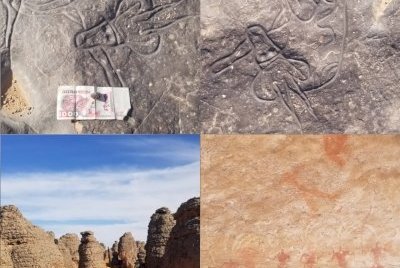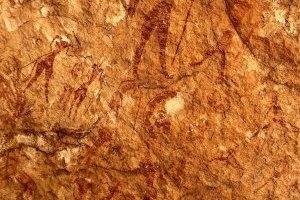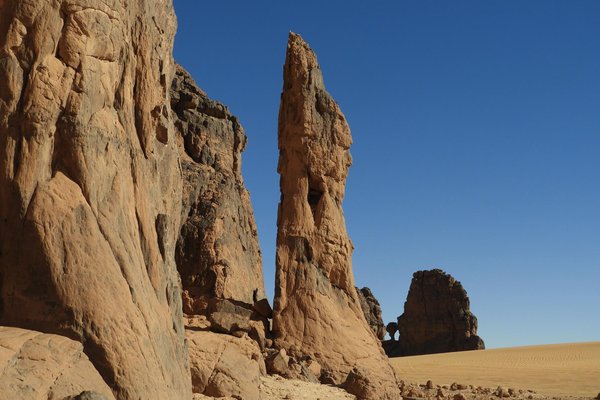Algeria
Tassili n'Ajjer
The Tassili n'Ajjer is a mountain range in the Sahara characterized by its impressive rock art and geological formation of sandstone "rock forests".
Erosion in the area has formed nearly 300 natural rock arches, along with many other spectacular landforms. Its prehistoric rock paintings and other ancient archaeological sites date from neolithic times when the local climate was much moister, with savannah rather than desert. Over 15,000 rock paintings have been inventoried.
Community Perspective: This area near the Libyan border is covered by regular ‘desert’ tours departing from Djanet, a city best reached by flight from Algiers.
Site Info
Official Information
- Full Name
- Tassili n'Ajjer (ID: 179)
- Country
- Algeria
- Status
-
Inscribed 1982
Site history
History of Tassili n'Ajjer
- 1982: Inscribed
- Inscribed
- Type
- Mixed
- Criteria
- i
- iii
- vii
- viii
Links
- UNESCO
- whc.unesco.org
- Related
-
- fjexpeditions.com — The Most Beautiful Desert of All
- en.wikipedia.org — Wiki on Tassili n'Ajjer
All Links
UNESCO.org
- whc.unesco.org — whc.unesco.org/
Related Resources
- fjexpeditions.com — The Most Beautiful Desert of All
- en.wikipedia.org — Wiki on Tassili n'Ajjer
Community Information
- Community Category
- Natural landscape: Desert
- Archaeological site: Rock Art
Travel Information
Guided Tour Only
Red Zone Travel Advisory
border area with Libya
Recent Connections
-
Historic climate change
"Criterion (iii): The rock art images c…
-
Perfect Inscriptions
1982 -
Red Zone Travel Advisory
border area with Libya
Connections of Tassili n'Ajjer
- Individual People
-
-
Théodore Monod
He contributed to the recognition of the importance of rock paintings and engravings in the Sahara, including those of Tassili n'Ajjer. Although he did not lead the major rock painting expeditions (Henri Lhote did that in the 1950s), Monod: Known, explored, and studied the Saharan massifs, including Tassili, contributed greatly to the scientific recognition of the Sahara as the cradle of ancient civilizations, encouraged and supported interdisciplinary research on Saharan prehistoric art, of which Tassili is the jewel. Was very critical of some of Lhote's overly sensationalist interpretations (such as the "ancient astronauts" hypothesis) — he advocated a rigorous and respectful approach to local cultures. -
Erich von Däniken
Many Round Head paintings portray 'strange' people with round, featureless heads and formless bodies. Erich von Däniken controversially described these paintings in his 1968 book "Chariots of the Gods?" as representing prehistoric, extra-terrestrial astronauts who had somehow influenced human evolution.
-
- Geography
-
-
Contiguous separate sites across national boundaries
With Tadrart Acacus, Algeria vs Libya -
Sahara
"with more than 15,000 drawings and engravings testifying to climate changes, wildlife migrations, and the evolution of humankind on the edge of the Sahara." (OUV)
-
- Trivia
-
-
Dubbed as another WHS
The Oued Djerat has been dubbed the "Vézère of the Sahara" because of its big naturalistic engravings.See fr.wikipedia.org
-
On Banknotes
1000 dinar; 1998, 2005See en.numista.com
-
- History
-
-
Historic climate change
"Criterion (iii): The rock art images cover a period of about 10,000 years. With the archaeological remains, they testify in a particularly lively manner to climate changes, changes in fauna and flora, and particularly to possibilities provided for farming and pastoral life (...)." (OUV)
-
Palaeolithic and Mesolithic
there are palaeolithic sites at Erg (formerly lake) Tihodaine (UNEP-WCMC) -
Berbers
The rock art includes Libyc and Tifinagh inscriptions (ancient and recent Tuareg/Berber script). The artists of the Horse Period art were ancestral Berbers, some of whose descendants are the modern Tuareg. -
Neolithic age
The site of Tassili was primarily occupied during the Neolithic period by transhumant pastoralist groups whose lifestyle benefitted both humans and livestock. There are numerous rock shelters within the sandstone forests, strewn with Neolithic artifacts including ceramic pots and potsherds, lithic arrowheads, bowls and grinders, beads, and jewelry. (wiki)
-
- Ecology
-
-
Aurochs
Images from the Large Wild Fauna Period (12,000 BP - c 6,000 BP) include aurochs. -
Natural Arches and Bridges
Numerous -
Critically endangered fauna species
Northwest African Cheetah (a.k.a. Saharan cheetah) (UNEP-WCMC) -
Bird Migrations
The entire region is important for resting migratory Palaearctic birds. (UNEP-WCMC) -
Sandstone Formations
The property is also of great geological and aesthetic interest: the panorama of geological formations with "rock forests" of eroded sandstone resembles a strange lunar landscape. (description Unesco website) -
Notable Trees
The Tassili Cypress only exists on the Tassili and is one of the oldest trees in the world after the Barbed Pine in the USA.
-
- World Heritage Process
- Religion and Belief
-
-
Shamanism
Among the rock paintings, there are depictions of ritual figures or shamans. (wiki)
-
- Human Activity
-
-
Erotic art
"Some scenes appear to portray sexuality, e.g. men with an erect penis." See also Tadrart Acacus for a similar tradition in Rock Art. -
Chariots
The paintings and engravings of the Horse Period commonly depict horses and horse-drawn chariots. -
Petroglyphs
-
Hunter-gatherers
The art of the Large Wild Fauna Period of the Round Head Period is attributed to hunter-gather peoples. -
Pastoralism
The site of Tassili was primarily occupied during the Neolithic period by transhumant pastoralist groups whose lifestyle benefitted both humans and livestock. The transition to pastoralism following the African Humid period during the early Holocene is reflected in Tassili n'Ajjer's archaeological material record, rock art, and zooarchaeology. Cattle were herded across vast areas as early as 3000-2000 BCE, reflecting the origins and spread of Pastoralism in the area. (Wikipedia) More recent paintings show cattle herders, which may have helped bring about the drier conditions in this part of the Sahara. (Ab Ev - IUCN) -
Writing systems
There are Libyc and Tifinagh inscriptions (ancient and recent Tuareg/Berber script). Tifinagh, which often accompanies images, is a later Lybico-Berber script still used by modern Tuareg. -
Pictographs
-
- Constructions
-
-
Tumuli
The lowlands have stone tumuli and hearths dating between 6000 to 4000 BCE. (wiki)
-
- WHS on Other Lists
-
-
World Biosphere Reserves
(1986) -
Ramsar Wetlands
La Vallée d'Iherir, 2001 -
IUGS Geological Heritage Sites
The Ordovician glacial pavements of the Tassili n’Ajjer
-
- Timeline
-
-
Built in the 6th millennium BC
-
Paleozoic
grès fluviatiles du Paléozoïque (env. 450 millions d'années) en cours d'ensablement par les dunes du grand erg oriental et granite érodé en 'boules' au premier plan (wiki)
-
- Science and Technology
-
-
Recorded cultural discoveries
It is the rock art (engravings and paintings) that have made Tassili world famous as from 1933, the date of its discovery. (Unesco) Tassili was already well known by the early 20th century, but Western eyes were fully introduced due to a series of sketches made by French legionnaires, specifically Lieutenant Brenans during the 1930s. He brought with him French archaeologist Henri Lhote, who would later return during 1956 - 1957, 1959, 1962, and 1970. (Wikipedia)
-
- Visiting conditions
-
-
Guided Tour Only
Officially one must be with a local guide at all times. You need to register on arrival at Djanet airport and the police will regularly check in with the guide who needs to bring a satellite phone if you hike into the Tadrart plateau. -
Red Zone Travel Advisory
border area with Libya
-
- WHS Names
-
-
Untranslated Toponyms
"Tassili" is a Tamahaq (a Northern Tuareg language) word meaning "Plateau" - in this case of the Ajjer tribespeople. Other uses of the word in Algeria include Tassili du Hoggar, Tassili de l’Immidir, Tassili de Tinrhert, and Tassili de Tamrit.
-
News
No news.
Community Reviews
Show full reviews
Tassili n'Ajjer is a real gem and I couldn't rate the park less than five stars without an explanation. For now you should know: this place is not to be missed of your bucket list!
One should also know that a) the core zone is not the entire park. It is only the marked rock painting/carving spots and a rather tiny rock forest near Djanet, which is still an impressive sight but pales compared to the natural beauty of the rest the park offers, especially the plateau in the east. b) the park according to Google map is only the rocky areas which doesn't include dunes and is even not stretching into the east. c) according to locals the park even includes Djanet and surrounding villages but I am not sure if that is true.
To reach the park you should fly in with Air Algiera, not a great airline but unfortunately the only option. Once you arrive you will immediately register with the police and they will contact your guide frequently about your location, even if you go hiking on the plateau so the tour will need a satellite phone, not that the police will be able to verify your location but they will know you are safe. After all this is very close to Libya and while no impact fron the civil war is felt here you could get lost or something. Forget about driving all the way south to Djanet. Checkpoints will stop you and …
Keep reading 0 comments
In the crossroads of modern-day Algeria, Libya and Niger, is the vast, the beautiful Tassili n'Ajjer National Park. I booked a two-hour flight from Algiers to Djanet - a 2200km+ journey that would have taken two full days (with rest and sleep stops) by land.
Mr. Hassani (Tinariwen Tours) welcomed me with a gift - a blue scarf - and instantly got me acquainted with how their group is most popularly described, Tuareg or the blue people. That cool February day, Mr. Hassani's indigo robe shone in the gold sand and brown rock forests.
"In the desert," he said, "the wind is the artist," and showed me curious geologic formations and contoured sand dunes. I went to Djanet in search of prehistoric rock art (see photo), and returned with remembrance of solitude and moments of temporary yet much-needed detachment from the material world.
Keep reading 0 comments
